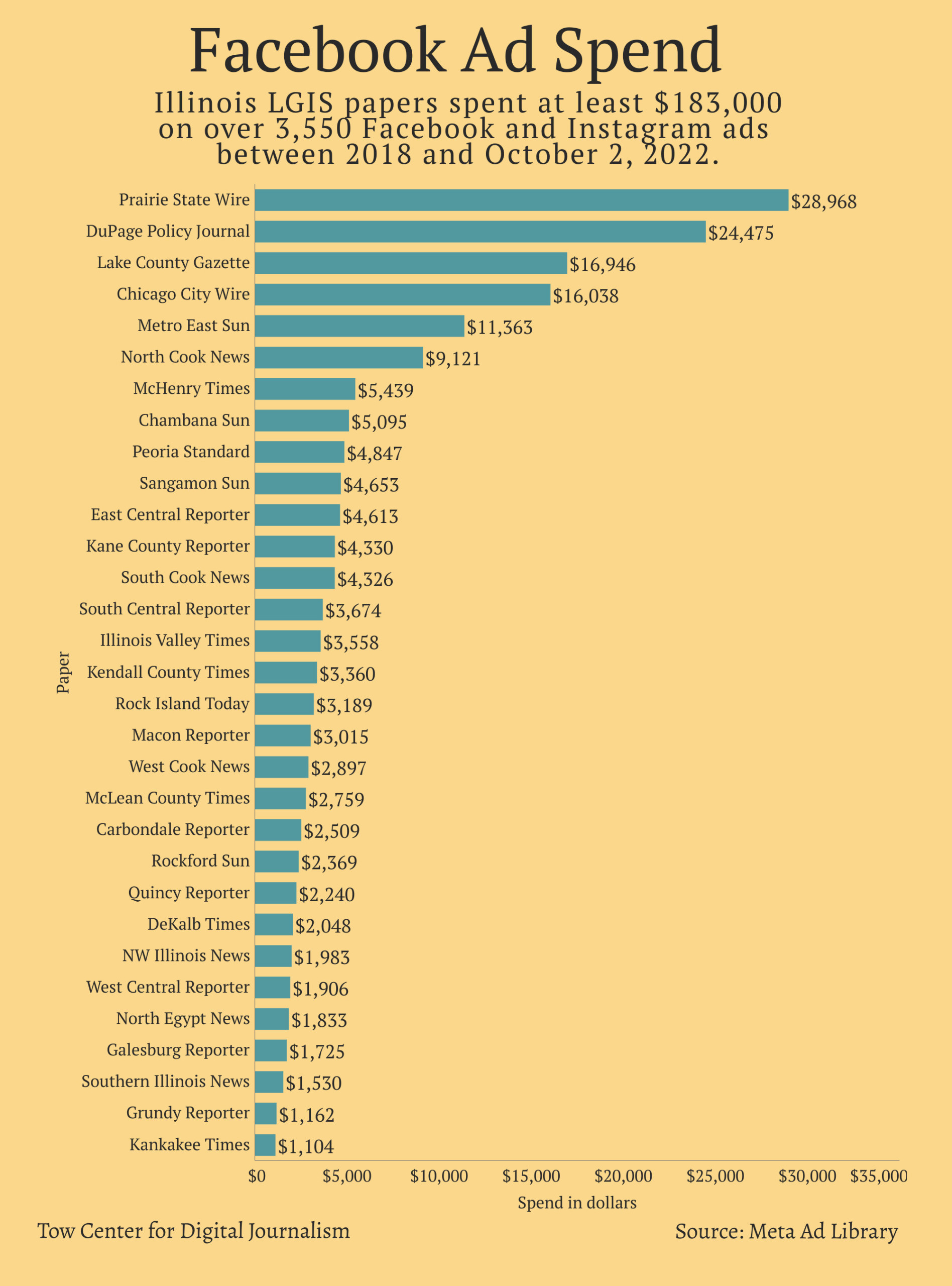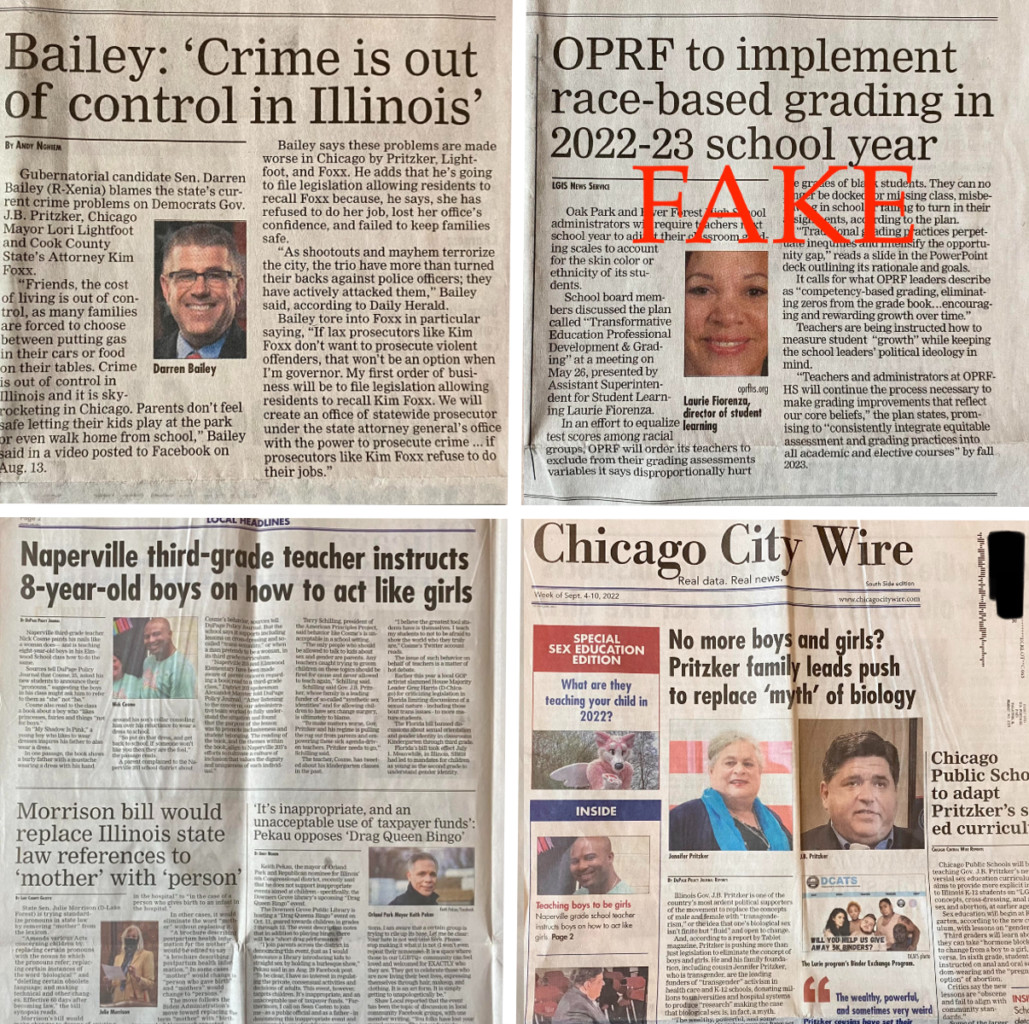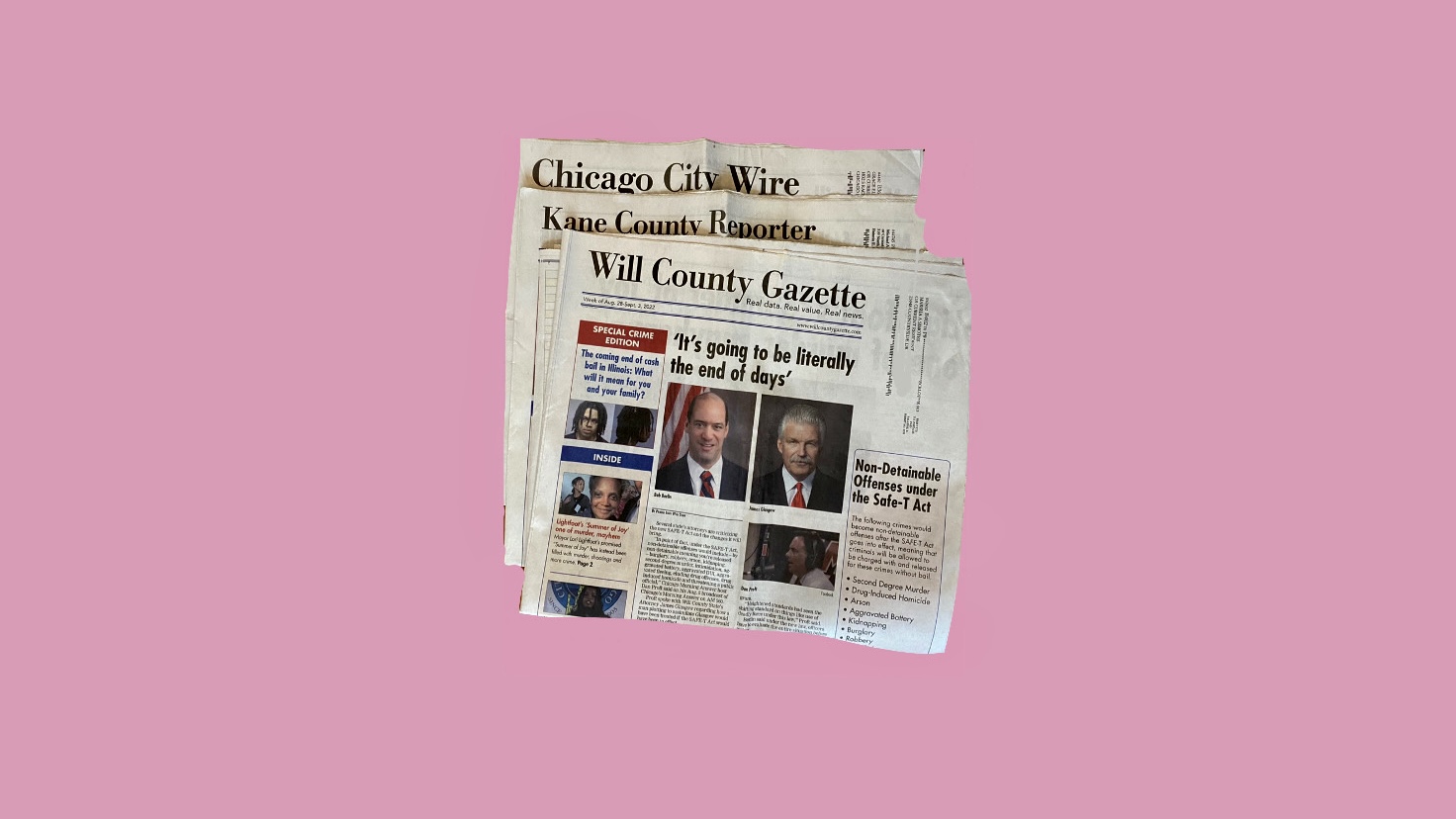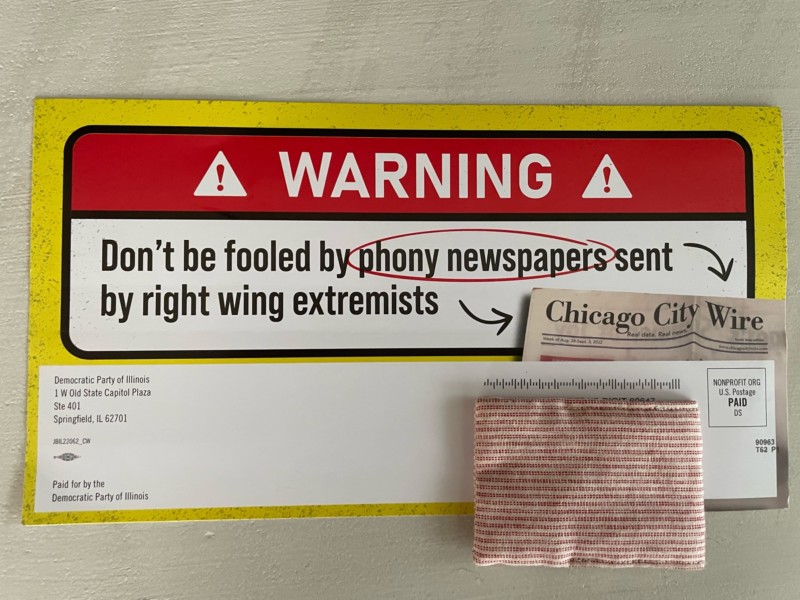Sign up for the daily CJR newsletter.
One recent afternoon, after returning home from his job for the parks and recreation department of his Illinois village, Michael Gnadt, twenty-two, went to check for a package in the mail and found a newspaper called the Kane County Reporter.
The paper featured scare stories on crime, covid, and culture war topics. Teachers were instructing children to be trans, it said, and dangerous murderers would be released without bail under a Democratic plan to reform cash bail, in a double-page spread of mug shots of mostly Black men. “It was vile stuff,” Gnadt said after researching more about the paper online. It particularly struck a chord because Gnadt felt it was questioning his very right to exist as part of the LGBTQ+ community. He was also disgusted by what he saw as racism. “It really tried to punch down on as many people as possible,” he said.
Gnadt’s household is one of hundreds of thousands a week across Illinois, according to one person familiar with the matter, to have received similar “newspapers” of late. The titles—such as the Kane County Reporter, Chicago City Wire, West Cook News, Dupage Policy Journal, Lake County Gazette, and Will County Gazette—are part of at least eleven physical offshoots of thirty-six online news sites published by Local Government Information Services, a “formidable conservative force” cofounded in 2016. They are connected to far-right activist Dan Proft, who also runs the Florida-based People Who Play by the Rules political action committee (pac), and focus much of their attention on attacking Illinois’s Democratic governor, J.B. Pritzker, and supporting his Trump-endorsed Republican challenger Darren Bailey. These papers, which were attacked by Pritzker as “racist,” as the Chicago Tribune first reported, feature multiple misleading, decontextualized, and often nonfactual stories on hot-button issues in Illinois.
While the papers claim to comprise honest local reporting—“Real data. Real news,” the slogan reads—they are part of a wider trend of the blurring of journalism and campaigning. This has sparked fears that, ahead of the midterms, readers are consuming divisive messages without realizing the true source. While papers of this kind tend to mimic the look and feel of local reporting, they are in fact funded by pacs or activists with agendas. “It has all the appearance and trappings of an official news organization, and it’s trying to hitch a ride off the credibility of newspapers built over time,” said Peter Adams, senior vice president of education at the News Literacy Project. “This crosses the boundary into propaganda.”
Terminology can be tricky in this field. Rick Pearson, the Chicago Tribune’s chief political reporter, told me he typically uses the terms “political advertising” or “misinformation” when referring to these papers. But LGIS has been cited multiple times by fact checkers—for Reuters, the AP, Factcheck.org, and more—for containing untrue content, yet continued to actively publish the same story across social media and in print.
Proft founded LGIS with conservative businessman Brian Timpone. Timpone built the sprawling Metric Media network of roughly twelve hundred news sites in all fifty states. The Tow Center has documented how these publications present themselves as providing community reporting but are deployed to trumpet right-wing talking points, serving as political platforms for allies and as tools in crisis management. Although the Illinois-based sites are not featured on Metric’s list of affiliated sites, they share the same visual template.
The papers are not entirely new. Back in 2016, Proft paid for a similar postal campaign through his former pac, Liberty Principles. But after a 2016 complaint about lack of funding disclosure, the Illinois State Board of Elections ruled he needed to add a disclaimer about where the money was coming from, according to documents shared by the board with the Tow Center. (Instead, he stopped paying through the pac.) This time around, funding sources for the latest iteration of LGIS newspapers is unknown, apart from a company disclaimer online that reads: “Funding for this news site is provided, in part, by advocacy groups who share our beliefs in limited government.” Matt Dietrich, public information officer at the Illinois State Board of Elections, told me “there is currently no evidence that his [Proft’s new] pac is paying for these newspapers.” Even if the pac were paying, Dietrich added, there would be no issue as long as funding was disclosed. “The only rule is an independent-expenditure pac cannot coordinate with a candidate’s campaign committee,” he said. Amid a lack of regulation around “pink slime” newspapers, and fears of lax media literacy among many US voters, the strategy of partisan leaflets disguised as neutral local news looks set to be a permanent fixture of this election cycle.
It also marks a challenge for legacy newspapers. When the Chicago City Wire started falling through letterboxes in August, it sparked a conversation in the 174-year-old Chicago Tribune newsroom about the ethics of amplification. Where is the tipping point at which reporting on mis- and disinformation ends up actually circulating it to a wider audience? “That’s a constant battle—there’s a fine line that many of us walk [reporting on] those attention seekers, like Dan Proft, who look to be covered by the media, versus to ignore them and not give them that vindication,” Pearson told me. “We did have that debate,” he added, but in this case, with the newsroom inundated with questions from readers about what these papers were and who funded them, “it was quite a clear-cut decision to write this story in the public interest.” It’s not always so easy.
The major worry is that, little more than a month out from the midterms, bad actors are targeting inflammatory and discordant issues—pressing the tender bruises of US politics—in ways designed to mislead and provoke. “We’ve seen that not just with this operation, but we’ve seen that with other operations with various organizations affiliated more to the right,” Pearson said. “There’s no doubt that in the current environment this is certainly taking advantage of the decimated media scene.” It’s also putting local news publishers in a tricky position. Tow Center reporting shows that LGIS—as well as the Epoch Times—is currently a commercial printing client of Gannett, the nation’s largest local news publisher.
FOR KARIN SULLIVAN, the period after finals and graduation is a sleepy time of year for Oak Park and River Forest High School, in the Chicago suburb of Oak Park. But on May 31, Sullivan, the executive director of communications and community, remembers coming out of a meeting to her phone blowing up with voicemails, emails, and Google alerts.
An online story from West Cook News, an LGIS news outlet, was saying the school had begun implementing “race-based grading,” where white kids would supposedly be downgraded in the interests of racial fairness. “Complete fabrication,” Sullivan told me. West Cook News latched onto the last presentation slide from a May 26 board meeting, which said the high school would use “evidence-backed research and the racial equity analysis tool” to examine grading practices, blowing it up into the lie that the school would be grading by race. The school, which has a diverse cohort and is part of a progressive community, had been the target of West Cook News attacks before. (Sullivan had even requested two corrections back in September 2021, according to emails seen by the Tow Center, but received no reply from West Cook News.) Yet Sullivan had seen nothing on the scale of this story.
The false narrative zipped around the right-wing media ecosystem. Within hours, a host of right-wing outlets ran similar versions of the story. Conservative news outlets built on the original story. Newsmax ran a segment on the allegation. The conservative National Review, without reaching out to the school, decried the plan as “bigotry.” Breitbart ran a similar story. The Lion, the outlet of the conservative Herzog Foundation, uploaded an article despite the school’s insistence, over email, that the allegation was untrue. The Daily Signal also reached out to Sullivan for comment. In the most brazen example, PJ Media contacted Sullivan only after publishing its version. “Is the allegation of race-based grading true [or] false, or a complex combination of facts? I wrote an article about this yesterday and I want to be accurate,” a PJ Media columnist wrote to Sullivan, emails seen by Tow show. Sullivan, saying the allegation was false, replied: “I’m a little unclear—you’ve already posted the article and now you’re fact-checking it after the fact? That does not sound like responsible journalism.”
Sullivan watched as the false narrative multiplied, shared by over seven thousand Facebook users in the first week, and was then amplified by right-wing influencers on social media. Accounts including those of Ann Coulter, a conservative media pundit with two million Twitter followers, Tom Fitton, a conservative activist with 1.5 million, and Steve Cortes, a former Trump campaign manager with over 340,000, generated thousands of engagements. The account @libsoftiktok, with 1.4 million Twitter followers and 880,000 on the Trump-backed network Truth Social, amplified the narrative further. The story garnered over fifteen thousand engagements (retweets, likes, and comments) on Twitter alone, according to Tow Center analysis. This spread fit a similar pattern identified by Stanford University’s Election Integrity Project throughout the 2020 election—that misinformation can spread both bottom-up, from concerned citizens, and top-down, from online trendsetters with a platform.
Fact checks from Reuters, AP, Factcheck.org, WGN Radio, the Daily Beast, USA Today, and Josh Kraushaar, senior political correspondent at Axios, and a Substack belonging to Donald Moynihan, a professor at Georgetown University’s School of Public Policy, attempted to set the record straight. (Kraushaar even admitted being duped at first.) But their posts labeling the allegation false drew far less engagement. The danger with all misinformation, says Adams of the News Literacy Project, is that its constant repetition across timelines, TV screens, and printed papers means even if it’s debunked it can leave a lasting impression. “Misinformation is so pernicious because it’s sticky,” he said. “There’s a danger the disinformation becomes unmoored from its source and comes to feel like conventional wisdom.”
West Cook News didn’t back down after a round of fact checks. Later in June the false story was promoted via paid advertising on Facebook and Instagram, according to parent company Meta’s ad library, with LGIS spending up to $100 on a four-day ad that garnered over three thousand impressions. The ad reached more women than men, with women aged forty-five to fifty—perhaps targeting mothers—those who were served the ad most on their timelines. This is small potatoes; West Cook News has spent just $2,897 on seventy-four ads since 2018, Meta data shows. But the LGIS papers in Illinois have plowed at least $183,000 into Facebook advertising for over thirty-five hundred ads in total.

Illinois LGIS papers spent at least $183,000 on over 3,550 Facebook and Instagram ads between 2018 and October 2, 2022.
Then it crossed over from the digital to the physical. In late August, LGIS began sending the printed newspapers through letterboxes across Illinois, dropping the same misleading “race-based grading” story—and many more—onto the doormats of voters. This is “the use of a product and delivery mechanism that is currently used with the clear aim to avoid disclosure that would be required through a pac,” Jon Berkon, a partner at Democrat-allied Elias Law Group, who has worked for the Pritzker campaign, told me. Pritzker, the target of scores of attacks in the papers, labeled the papers “racist.” “The fate of our communities and trusted local journalism are intrinsically linked,” Pritzker, who is worth around $3.6 billion, making him the wealthiest US politician in office, told the Tow Center. Days later, Bailey, his challenger—FiveThirtyEight rates Bailey’s chances as minuscule—appeared on Proft’s radio show to discuss the fallout as the disinformation stretched its arms across as many platforms as possible. “It’s one large echo chamber,” Pearson, of the Chicago Tribune, told me.

LGIS papers feature multiple misleading, decontextualized, and often nonfactual stories on hot-button issues in Illinois.
The episode also touched on the tricky situations some local publishers find themselves in amid the collapse of advertising revenue. The LGIS papers were printed in Schaumburg by Paddock Publications, which owns Chicago newspaper the Daily Herald and runs a commercial printing operation. The column inches of disinformation in the LGIS papers were delivered from a third-class USPS postage license belonging to the Herald’s owner, which made Paddock the target of critique from the Pritzker campaign for distributing information running counter to the Herald’s “commitment to the public good and to fair and objective journalism.”
The Herald owner “took million[s] of dollars in payments from LGIS over a seven-year period to publish and distribute the chain’s newspapers,” an LGIS paper wrote, which Paddock did not deny in emails to the Tow Center. Paddock canceled LGIS’s contract in September—a spokesperson said it would formalize its commercial screening process, add publishing disclaimers in sensitive cases, and strengthen the commercial/editorial separation—but defended the need to diversify revenue amid a “historic downturn” in local news. But Proft, on Twitter, didn’t seem fazed by Paddock canceling LGIS’s contract. The papers had already found a new publisher, he said.
Gannett, the nation’s largest local newspaper chain, is currently printing LGIS content. LGIS “are a commercial print client,” a Gannett spokesperson said by email. The Epoch Times, which has been labeled “a leading purveyor of right-wing misinformation” by the New York Times, is also a commercial client. Asked directly whether printing these papers ran counter to an online Gannett mission statement “to serve as a forum for better understanding and unity to help make the USA truly one nation,” the spokesperson said: “We do not discuss our clients and have no further comment.”
Gannett has struggled in a worsening business environment for local news, with a net loss of $136 million in 2021, according to its last annual Securities and Exchange Commission filing, following a net loss of $672 million in 2020 and of $121 million in 2019. “Our indebtedness could materially and adversely affect our business or financial condition,” Gannett wrote in its filing. It added: “The company provides commercial printing services to third parties as a means to generate incremental revenue and utilize excess printing capacity.”
Responding to LGIS, the Democratic Party of Illinois is sending its own leaflets to voters. “WARNING: Don’t be fooled by phony newspapers sent by right wing extremists,” these read, with arrows pointing to a reproduced Chicago City Wire issue. “What’s particularly egregious about these papers is that they are blatantly lying ahead of a competitive midterm election. Clearly, the goal here is to mislead,” Natalie Edelstein, communications director at Pritzker’s JB for Governor campaign, told me. “The first line of defense here is being forceful in communicating exactly what these are, which are Republican propaganda papers.”
Neither West Cook News nor LGIS cofounder Proft replied to a request for comment. But Proft was quoted in the Capitol Fax blog: “The Daily Herald is just another staffer in Pritzker’s comm shop which masquerades as the Chicago press corps.… The whorish response from the Herald is surprising? Hardly. Like Cato’s Letters, the papers will continue to be printed and distributed even if we have to return to the Gutenberg press and must enlist fair-minded people across Illinois who want the truth, not Pritzker’s ‘truth,’ to hand deliver them door-to-door.”
When Bart Koziol, a thirty-one-year-old mechanical engineer in Chicago, got back to his apartment from walking his dog and found a copy of the Chicago City Wire in the mail, he recognized there was something off. Koziol, who is a registered Democrat, noticed unflattering pictures of Democratic politicians yelling beside photos of smiling Republicans. He could find no information on the source—a business address or a masthead—like with other newspapers. Later that day, when Koziol walked out the doorway past the mailboxes for the eighty-five-unit apartment block, he saw a gray trash can filled with dozens of newspapers.
Thank you to Tow Computational Fellow Priyanjana Bengani for contributing to this article.
Has America ever needed a media defender more than now? Help us by joining CJR today.










